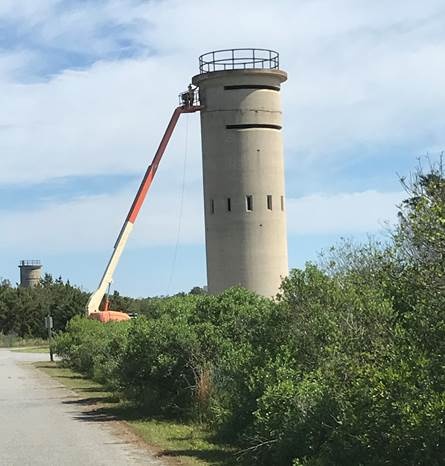
In the early morning hours of February 27, 1942, the 7,451-ton tanker R.P. Resor was running parallel to the New Jersey shoreline, en route from Texas to Fall River, Massachusetts. Under the dim light of a quarter moon, the ship’s lookout spotted the running lights from what appeared to be a fishing vessel on their port side. Barely 18 miles offshore, the captain of the surfaced German submarine U-578 had purposely flashed the sub’s running lights to confuse the oil carrier. Moments later, a torpedo was launched, striking the tanker on its port side. Minutes later, a second torpedo found its mark. The ensuing flames which engulfed the entire ship rose some 200 feet in the air. The inferno was then clearly visible from shore at Sea Grit and Manasquan Inlet. All but two of the tanker’s 43-man crew were lost.

The U. S. Navy later reported that in barely one month, the R.P. Resor was the 26th ship sunk or damaged by enemy action in the U.S. Atlantic. The tanker now lies scattered over 400 feet at a depth of 125 feet, some 34 miles from Manasquan Inlet. Its remains, a popular Scuba dive and fishing site, have become a habitat for a large variety of marine life.
At the outset of the European war, our military recognized that the Nation was ill-prepared for another global conflict. The mouth of Delaware Bay, the entry point for Philadelphia’s Naval Shipyard, New Jersey and Pennsylvania oil refineries and DuPont munitions and chemical plants in Wilmington were guarded by only two batteries of 155 mm guns. Both of them were positioned well away from the bay’s entrance. It also became obvious that German battleships were capable of shelling U. S. shoreline assets, well out of range of our coastal defenses.
In November of 1939, plans were made to install coastal artillery batteries at Cape Henlopen, Delaware. It had been determined that the installations would benefit from the area’s sand dunes. Their great height would help conceal them from any ocean approach.
Construction on the concrete bunkers moved forward during the summer of 1941. Fort Miles, as it was eventually named, had a 15,000-square foot fortified underground chamber (Battery 519). It now serves as the Fort Miles Museum. Battery 519 was equipped with two 12-inch guns. Nearby Battery Smith (Battery 118) housed two 16-inch guns while Battery Herring (Battery 221) and Hunter (Battery 222) were armed with 6-inch guns. Manned by approximately 2,500 soldiers, together they were the most heavily armed base on the Atlantic’s east coast.
On New Jersey’s side to the entrance of Delaware Bay, the two bunkers were armed with 6-inch guns. One was located near Cape May Point, the other next to Cape May Lighthouse.
Along with the construction of the coastal batteries, 15 towers were erected in support of the gun emplacements. Eleven were located on Delaware beaches, from Fort Miles to South Bethany. The four others were located in New Jersey, one at Cape May (517 Sunset Blvd -still existing), the other is part of Cape May’s Grand Hotel, rising above the hotel’s roof (not accessible to the public). The other two, located in Wildwood Crest and North Wildwood, were demolished after the war. All of the towers were positioned to allow an unobstructed view of the Atlantic and the crucial entrance to Delaware Bay. They served as lookout decks and fire control stations that assisted in directing shell fire toward a detected enemy vessel. Ranging from a height of 37 to 90 feet, horizontal rectangular openings ran about one-third their way around the towers, at one or more floor levels. They served as observation windows. Telephone cables connected the towers to the coastal batteries.
From the towers, lookouts scanned the horizon with binoculars and high-powered, specialized telescopes that allowed the operators to determine the angle (in degrees) from the tower to the target. At the same time, personnel from another tower also zeroed in on the same target and then called in the resulting triangulation to the battery. A bell, which was rung at regular intervals, allowed the personnel to predict the location of the ship, a short time in advance, as it moved through the water.
To prevent U-boats from entering the bay, the US Navy deployed remotely detonated mines, anti-submarine net and underwater listening devices. If propeller noises were detected, artillery fire and remote detonation of the mines would have been initiated. But no German submarines were ever known to have attempted entry into Delaware Bay. And though Fort Miles was well equipped for any enemy vessel, no shot was ever fired in its defense! U-578, the submarine that destroyed the tanker R. P. Resor and at least four other vessels was attacked and sunk by a Czechoslovakian aircraft in the Bay of Biscay (south western coast of France) on August 10, 1942. None of her crew survived.
From Maine to Florida and the Pacific coast north to Alaska, observation/fire control towers similarly operated during World War ll. But Delaware and New Jersey’s cylindrical concrete structures were unique among the others. Some of the towers were square while others resembled forest lookout towers. Certain lighthouses such as Florida’s Gasparilla Island Light and Port Boca Grande Light also served as lookouts.
Tower No. 7, at Delaware’s Cape Henlopen Park is open to the public as is Tower No. 23 at Cape May, New Jersey. From the top of these towers, visitors and can scan the entire area including out to the Atlantic. Tower No. 3, located along Route 1, at Delaware Seashore State Park is expected to also be opened after the completion of its restoration.
The Fort Miles Museum (Battery 519), just 2/10 of a mile past Tower No. 7, features a 16-in gun whose barrel was taken from the battleship USS Missouri, the American warship that was the site of the Japanese surrender on September 2, 1945. Also on display are the typical underwater mines that helped protect the mouth of Delaware Bay, a 12-in gun, examples of powder bags used to ignite the gun and typical projectiles. The Museum also scheduled demonstrations of simulated (sound only) firings of the 12-inch gun. A trip to any of these sites is an opportunity to experience part of our Nation’s World War II history.
Fort Miles and Tower #7 are located in the 5,192-acre Delaware Cape Henlopen State Park.
For more information, go to: https://destateparks.com/Beaches/CapeHenlopen
Fire Control Tower #23 stands near the Cape May Lighthouse. For more information, go to: https://www.capemay.com/play/cape-may-shopping-directory.
